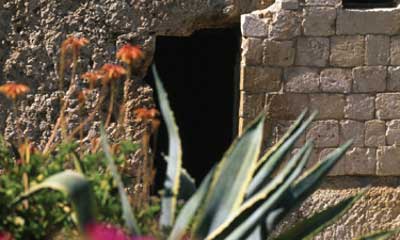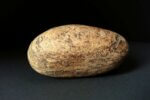When you enter its gates, you are not ushered into a sacred shrine. There are no candles, no incense. Instead, you enter a mini paradise of majestic trees, luxuriant plants and beautiful flowers. If you glance to your left and below a small crag, you see a tomb carved by hand into large, smooth rock. There is no adornment to mark the spot and no fanfare to herald it.
This is the Garden Tomb—which was missed by Helena, mother of Roman Emperor Constantine, when she visited the Holy Land in the fourth century and selected “holy sites” that she believed marked the spots of significant biblical events.
Helena is traditionally given credit for finding the remains of the cross, and, consequently, her son ordered the building of the Church of the Holy Sepulchre beside these relics. Nearly a million pilgrims visit this massive church today and wait in long lines to enter the tomb that most Roman Catholic, Orthodox and Coptic Christians believe is the actual tomb from which Jesus rose. However, archaeologists have not been able to declare with certainty that the Church of the Holy Sepulchre hovers over the original tomb owned by Joseph of Arimathea.
Charles Gordon, a famously heroic British general during the 19th century, was in Jerusalem in the late 1800s and conducted his own investigation into the site of Jesus’ burial and resurrection. After reading the Resurrection account while in Jerusalem, he recalled the sight of a jagged rock face at a nearby quarry that eerily resembled a human skull. Gordon became convinced that this was Golgotha (which in Hebrew means “place of the skull”), the site where Jesus was crucified, according to the Gospel accounts.
Other pilgrims preceding Gordon had recorded similar thoughts in their journals. They included Col. Claude R. Conder in 1870, who conducted surveys in Palestine as a member of the British Corps of Royal Engineers, and German theologian and scholar Otto Thenius in 1842.
It was due to Gordon’s efforts, however, that many began to seriously look at the site of the Garden Tomb as a possible location for the crucifixion and resurrection of Jesus. His claims, supported in part by the writings of Conrad Schick, a German archaeologist and missionary, brought other archaeologists to examine the site.
During Gordon’s era, archaeologists began to dig into the soil adjacent to this quarry. There they discovered an ancient garden—so large and sophisticated that only a wealthy man, someone like Joseph of Arimathea, could have owned and operated it (see Matt. 27:57-60).
Though the archaeology of the Garden Tomb has always been a point of academic debate, there have been noted archaeologists—Kathleen Kenyon, for one; the British archaeologist best known for her excavations of Jericho in the mid-20th century—who have described the tomb as a good example of a Second Temple Period burial site.
Compelling Evidence
For this story I interviewed my dear friend and newly appointed director of the Garden Tomb, Richard Meryon. Like Gordon, Meryon is British and had a distinguished career as a high-ranking military officer (in the Royal Navy).
Meryon notes that there is a detail in the gospel account that is significant in both a spiritual and historical sense. Luke 24:4-5 records that women who were followers of Jesus arrived at His tomb and that suddenly “two men stood by them in shining garments.” They then asked the women, “Why do you seek the living among the dead?”
Meryon notes that adjacent to the garden, archeologists have discovered 17 graves (a fact that could add clarity to the angels’ reference to seeking “the living among the dead”). Only four of these graves are hand-carved into rock—a physical feature noted in the New Testament account (see Matt. 27:60).
Meryon adds that none of these four graves have a track below the entrance, which allows for a large, heavy stone to be rolled away to the side and remain there—something that is recorded as happening after the earthquake on the first Resurrection Sunday (see Matt. 28:2). The Garden Tomb is also the only one of these tombs that has the burial chamber on the right. This is a detail mentioned in Mark 16:5.
While the official policy of the Garden Tomb Association (a U.K.-based ministry with stewardship of the site) makes no claims that this site is the tomb in which Jesus was buried, many people over the years have come to believe that it may indeed be. These beliefs are based on a variety of considerations that underscore why the garden so clearly fits the description provided by the writers of the New Testament—such as John’s simple word-picture: “At the place where Jesus was crucified, there was a garden” (John 19:41).
Based on the Bible’s description of the site of the Crucifixion, the Garden Tomb meets the following criteria. It is:
» Outside the city walls of Jerusalem
» Near a gate of the city
» Along a busy thoroughfare
» At a place of public execution
» At the place of the skull (Golgotha)
» In a nearby garden
Based as well on the Bible’s description of Jesus’ burial site, the Garden Tomb is:
- Located in a garden
- The type that would have belonged only to a wealthy person
- Hewn out of the rock
- Designed with a channel for a rolling stone to seal the doorway
- Entered through a low doorway
- Built with a chamber situated to the right of the entrance
During an interview with CBN News, Meryon said: “What we do have here in the garden is a perfect representation of the biblical accounts at the end of the four Gospels. Everything in those four Gospels matches what we show people here in the garden.”
I probed for more evidence that the Garden Tomb may be the actual one where Jesus was buried. Meryon preferred not to elaborate. Instead, he said that if archaeologists could definitively prove that it is the authentic site, pilgrims would probably end up worshipping the place more than the Person.
He preferred to focus on the more central issue, the key point every guide at the garden reminds visitors: “It really doesn’t matter where Jesus was buried and from which tomb He rose. The important thing is, He rose.”
Testifying to the Truth
Many Christian visitors to Israel say their visit to the Garden Tomb is the highlight of their entire tour. Because the garden has retained its simplicity, it gives viewers a feel of what it would have been like to be with Jesus in Jerusalem 2,000 years ago.
Since the 1980s I have had the privilege to serve as the senior pastor of King of Kings Community in Jerusalem. For more than 25 of those years our worship team has led 1,000 to 1,500 pilgrims and locals in celebration at the Resurrection Sunday sunrise service. At this service, and the three others that follow it, distinguished guest preachers boldly proclaim the gospel over the sound system, with Muslim and Jewish neighbors within earshot.
The preacher needs no props or video clips to illustrate his sermon. Everything he needs is already there: an ancient press where grapes were crushed, which recalls the crushing of the Savior on the cross and His blood pouring out to pay for our sins; the ancient cistern and water system, which reminds us of how our ever-living Savior provides living water for the thirsty soul; the skull-like rock face on the eastern edge of the garden; and the tomb itself.
The garden, therefore, is not only a powerful visual aid and reminder of the historicity of the Resurrection, but it is also a place where today Jesus comes alive in new hearts. Meryon’s eyes light up as he reports that just a week ago a Muslim lady was so moved by the presence of the living Lord that she gave her life to Him.
On one “open house” day last year, approximately 1,000 Israeli and mostly secular Jews visited the garden. Because the gospel is the central message, the Garden Tomb Association has a policy that only born-again Christian guides may lead guests around the garden. Other Israeli government-licensed guides are welcomed, but instead of working, they get a well-deserved break and are treated to refreshments and warm hospitality.
So no one—no matter their race or religion—leaves the garden without first hearing a clear proclamation of the gospel.
The Defense Rests
The Garden Tomb’s 260,000 annual visitors are mostly Protestant believers. Yet often there are unbelieving loved ones who also join these tours. After hearing the Good News at a place such as the Garden Tomb, many end up becoming believers themselves.
Almost invariably Catholics who visit the Garden Tomb, as well as their favored Church of the Holy Sepulchre, are also deeply touched. One priest said, “Even if it isn’t the real place, it should be.”
Meryon lights up again when he mentions that the Israeli tour guides voted the Garden Tomb as the top tourist site in 2009. “This is not just a holy site; it’s a happy site,” he says, emphasizing why people enjoy their garden visit.
I asked Meryon if there were any special gatherings that really stand out among those that take place at the garden throughout the year. I expected him to say the services on Resurrection Sunday are the highlight.
Instead, he pointed out a new phenomenon. Twice in the last two years several hundred Arab believers and their Jewish Messianic brothers and sisters gathered to worship together at the garden. Such a demonstration of love and reconciliation may be one of the most powerful symbols for bringing hope for real, eternal peace in this troubled land.
A resident of Jerusalem since 1983, Wayne Hilsden is the senior pastor of King of Kings Community church. He leads the King of Kings Ministry team, preaches regularly in Jerusalem and travels internationally speaking on the restoration of Israel.
design Pics/ Natural Selection Ralph Curtin







Leave a Comment
You must be logged in to post a comment.